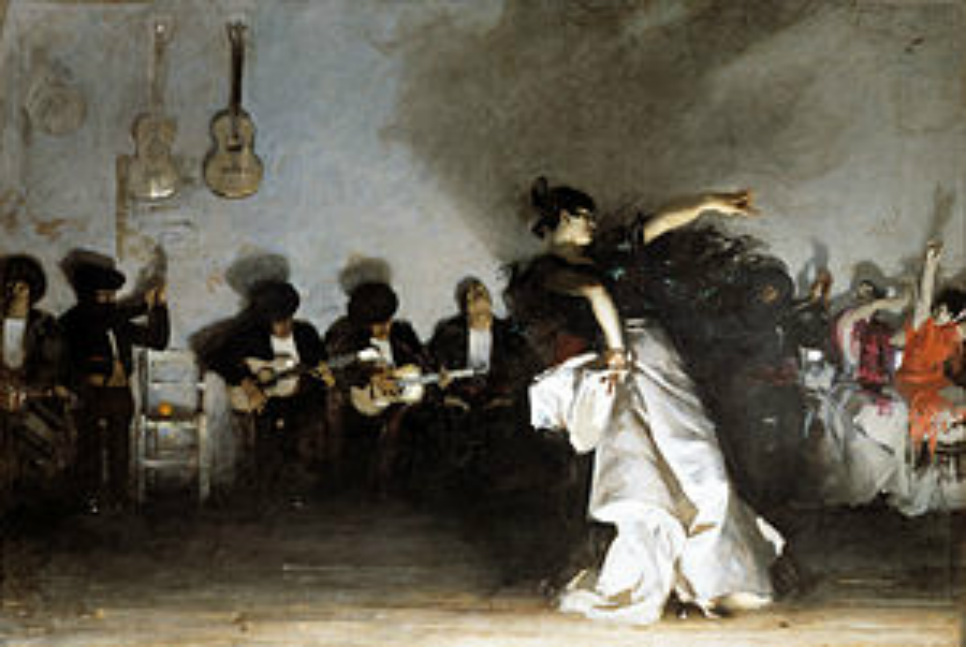Flamenco

El Jaleo, 1882.
Oil on canvas, 237 × 352 cm.
Isabella Stewart Gardner Museum.
Flamenco is a mysterious culture that can be traced to 800 and 900 A.D. with many hypothesis promising to explain the meaning of the word flamenco, and sometimes they shortfall in evidence to confirm them. It is said that the word Flamenco is Arabic influenced by the word fellahmengu (translating to ‘expelled peasant’). Another theory was that Flamenco meant Flemish in Spanish. Either way, it is said that Flamenco and its gypsy people travelled from India, across North Africa into Andalucia (Southern Spain). Moreover, for 800 years, Andalucia was ruled by Islamic culture (Islamic Empire).
There are many influences in Flamenco music, song and dance. In Flamenco dance, the elements in movement with percussive footwork, splayed fingers, body and arm movements of sharp angles all resemble dances of East India like Katak, NianiPuri, Kathakal and Bharatanatyam. The music and song has a potpourri of rich influences like Jewish Synagogue Chants, Arabic Zayal, Islamic Empire Andalusian Orchestras, Indian singing of Punjabi, and Regional Andalucian folk. In addition to that, another influence was from Western African ascendancy by the way of Central and South American, and the New World Caribbean through the medium of the slaves.
It is also known that Flamenco derived from the suffering of the gypsies in Spain during their oppression from Spanish government where they were placed in Gitanerias (gypsy ghettos). It was there where the power of Flamenco music, song and dance was born from the chants and lamentations of their cante jondo (deep dark song - related to suffering) to their cante chico (happy short song). It was in the gitanerias where Flamenco was able to develop fully into what it is today. The Flamenco dancer expresses in movement from what the music gives (via guitar and song). In Flamenco dance, the dancer not only moves with feeling, but also listens to the technicalities of the structure just the way mainstream music is written today. In music, there are breaks, phrase closings, bridges, and much more; the flamenco dancer also has the same work ethics. However, when the guitarist plays for a Flamenco dancer, it is up to the guitarist to follow the dancer, yet the dancer must have clear technical structure changes in order for the guitarist to understand his or her musical interpretation.
There are many influences in Flamenco music, song and dance. In Flamenco dance, the elements in movement with percussive footwork, splayed fingers, body and arm movements of sharp angles all resemble dances of East India like Katak, NianiPuri, Kathakal and Bharatanatyam. The music and song has a potpourri of rich influences like Jewish Synagogue Chants, Arabic Zayal, Islamic Empire Andalusian Orchestras, Indian singing of Punjabi, and Regional Andalucian folk. In addition to that, another influence was from Western African ascendancy by the way of Central and South American, and the New World Caribbean through the medium of the slaves.
It is also known that Flamenco derived from the suffering of the gypsies in Spain during their oppression from Spanish government where they were placed in Gitanerias (gypsy ghettos). It was there where the power of Flamenco music, song and dance was born from the chants and lamentations of their cante jondo (deep dark song - related to suffering) to their cante chico (happy short song). It was in the gitanerias where Flamenco was able to develop fully into what it is today. The Flamenco dancer expresses in movement from what the music gives (via guitar and song). In Flamenco dance, the dancer not only moves with feeling, but also listens to the technicalities of the structure just the way mainstream music is written today. In music, there are breaks, phrase closings, bridges, and much more; the flamenco dancer also has the same work ethics. However, when the guitarist plays for a Flamenco dancer, it is up to the guitarist to follow the dancer, yet the dancer must have clear technical structure changes in order for the guitarist to understand his or her musical interpretation.